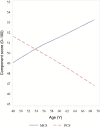Midlife Predictors of Health-Related Quality of Life in Older Women
- PMID: 29596565
- PMCID: PMC6175022
- DOI: 10.1093/gerona/gly062
Midlife Predictors of Health-Related Quality of Life in Older Women
Abstract
Background: Midlife represents an important time to evaluate health status and health behaviors that may affect health-related quality of life (HRQL) in later years. This study examines change in women's HRQL over 11 years from ages 47-59 to 57-69 and identifies midlife characteristics that predict HRQL at older ages.
Methods: Physical (PCS) and mental component summaries (MCS) of the SF-36 were used to assess HRQL from 2002 to 2013 in 2,614 women from the Study of Women's Health Across the Nation (SWAN), a multiethnic/racial cohort study. We used locally weighted scatterplot smoothing (LOESS) models to obtain unadjusted predicted mean trajectories of PCS and MCS as a function of age.
Results: LOESS predicted PCS declined from 51.6 to 47.1, whereas MCS increased from 49.2 to 53.1. In multivariable models, controlling for baseline PCS, higher baseline physical activity (p = .002) and increase in physical activity from baseline (p < .0001) predicted better PCS. Time since baseline (ie, aging; p < .001), higher baseline body mass index (p < .0001), increased body mass index over time (p < .0001), smoking (p < .05), two or more medical conditions (p < .0001), sleep problems (p < .0001), and urinary incontinence (p < .0001) were related to lower PCS. Early (p = .004) and late postmenopause (p = .001; vs. premenopause) and aging (p = .05) predicted higher MCS. Predictors of lower MCS were less than very good health (p < .0001), sleep problems (p < .0001), stressful life events (p < .0001), higher perceived stress (p < .0001), and higher trait anxiety (p = .004). Race/ethnicity was related to MCS, but not PCS.
Conclusions: Several potentially modifiable midlife factors, such as improved sleep hygiene, physical activity, and body mass index, might improve HRQL for older women.
Figures
Similar articles
-
The Role of Sexual Function in Quality of Life Among Midlife and Older Women: The Study of Women's Health Across the Nation.J Womens Health (Larchmt). 2024 Apr;33(4):426-434. doi: 10.1089/jwh.2023.0439. Epub 2024 Feb 8. J Womens Health (Larchmt). 2024. PMID: 38330428 Free PMC article.
-
Consequences of incontinence for women during the menopausal transition and early postmenopause: observations from the Seattle Midlife Women's Health Study.Menopause. 2013 Sep;20(9):915-21. doi: 10.1097/GME.0b013e318284481a. Menopause. 2013. PMID: 23531687 Free PMC article.
-
Variables explaining health-related quality of life in community-dwelling older adults.J Geriatr Phys Ther. 2014 Apr-Jun;37(2):83-91. doi: 10.1519/JPT.0b013e3182a4791b. J Geriatr Phys Ther. 2014. PMID: 23959246
-
Midlife Factors Related to Psychological Well-Being at an Older Age: Study of Women's Health Across the Nation.J Womens Health (Larchmt). 2021 Mar;30(3):332-340. doi: 10.1089/jwh.2020.8479. Epub 2020 Oct 22. J Womens Health (Larchmt). 2021. PMID: 33090934 Free PMC article.
-
Physical Activity and Physical Function: Moving and Aging.Obstet Gynecol Clin North Am. 2018 Dec;45(4):723-736. doi: 10.1016/j.ogc.2018.07.009. Epub 2018 Oct 25. Obstet Gynecol Clin North Am. 2018. PMID: 30401553 Free PMC article. Review.
Cited by
-
The relationship between psychological distress, depressive symptoms, emotional eating behaviors and the health-related quality of life of middle-aged korean females: a serial mediation model.BMC Nurs. 2023 Apr 23;22(1):132. doi: 10.1186/s12912-023-01303-y. BMC Nurs. 2023. PMID: 37087430 Free PMC article.
-
Factors Associated with Health-Related Quality of Life among Older Adults in Rural South Korea Based on Ecological Model.Int J Environ Res Public Health. 2022 Jun 8;19(12):7021. doi: 10.3390/ijerph19127021. Int J Environ Res Public Health. 2022. PMID: 35742266 Free PMC article.
-
Physical and Behavioral Factors Associated With Improvement in Physical Health and Function Among US Women During Midlife.JAMA Netw Open. 2023 May 1;6(5):e2311012. doi: 10.1001/jamanetworkopen.2023.11012. JAMA Netw Open. 2023. PMID: 37126345 Free PMC article.
-
Health-related quality of life among breast cancer survivors and noncancer controls over 10 years: Pink SWAN.Cancer. 2020 May 15;126(10):2296-2304. doi: 10.1002/cncr.32757. Epub 2020 Feb 27. Cancer. 2020. PMID: 32105350 Free PMC article.
-
Factors associated with health-related quality of life in a working population in Singapore.Epidemiol Health. 2020;42:e2020048. doi: 10.4178/epih.e2020048. Epub 2020 Jun 30. Epidemiol Health. 2020. PMID: 32660219 Free PMC article.
References
-
- Centers for Disease Control and Prevention. The State of Aging and Health in America 2013. Atlanta, GA: US Department of Health and Human Services; 2013. https://www.cdc.gov/aging/agingdata/data-portal/state-aging-health.html.
-
- Cleary P, Wilson I, Fowler F. A theoretical framework for assessing and analyzing health-related quality of life. In: Albrecht GL, Fitzpatrick R, eds. Advances in Medical Sociology. Vol V. Quality of Life in Health Care. Greenwich, CT: JAI Press; 1994: 23–41.
-
- Otero-Rodríguez A, León-Muñoz LM, Balboa-Castillo T, Banegas JR, Rodríguez-Artalejo F, Guallar-Castillón P. Change in health-related quality of life as a predictor of mortality in the older adults. Qual Life Res. 2010;19:15–23. doi:10.1007/s11136-009-9561-4 - PubMed
-
- Tsai SY, Chi LY, Lee CH, Chou P. Health-related quality of life as a predictor of mortality among community-dwelling older persons. Eur J Epidemiol. 2007;22:19–26. doi:10.1007/s10654-006-9092-z - PubMed
Publication types
MeSH terms
Grants and funding
LinkOut - more resources
Full Text Sources
Other Literature Sources
Medical


